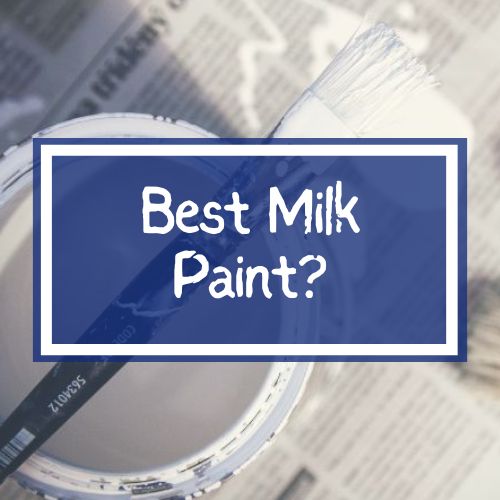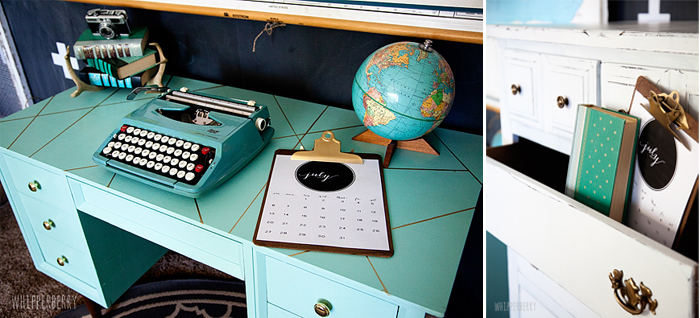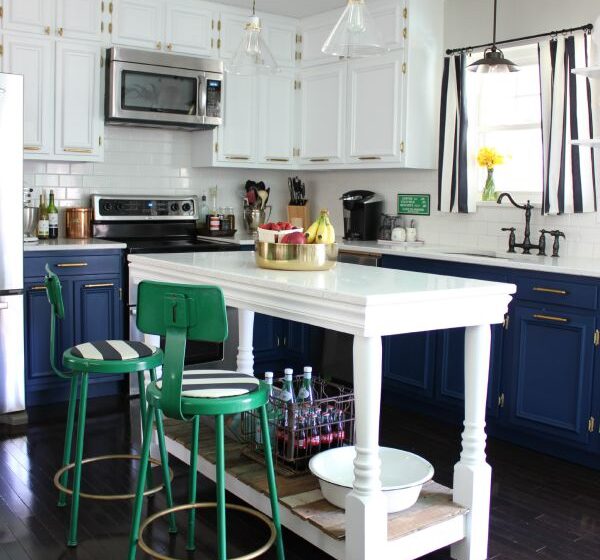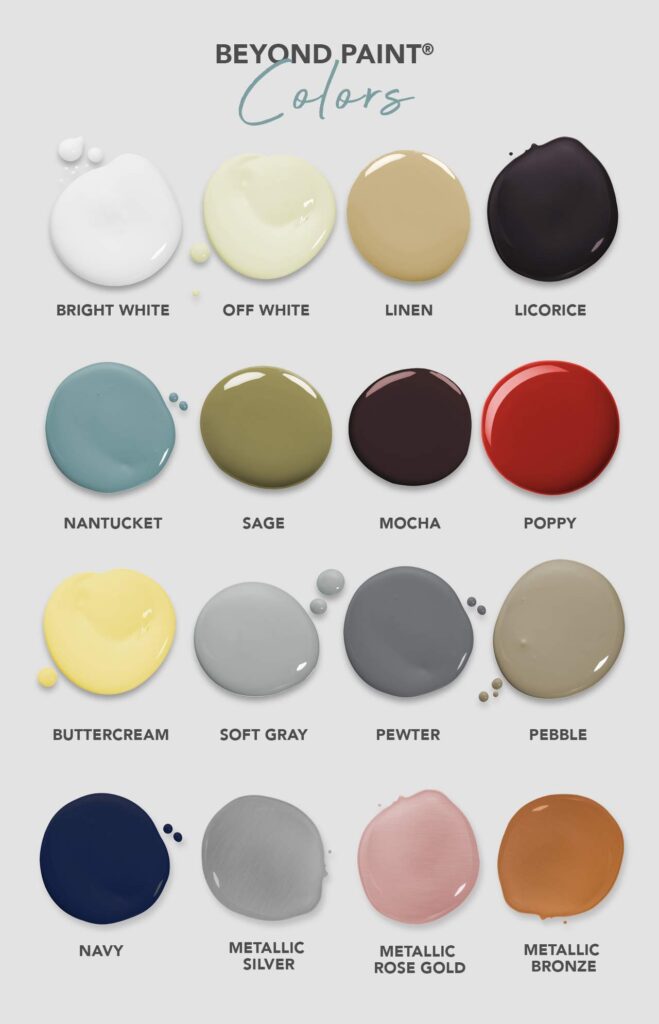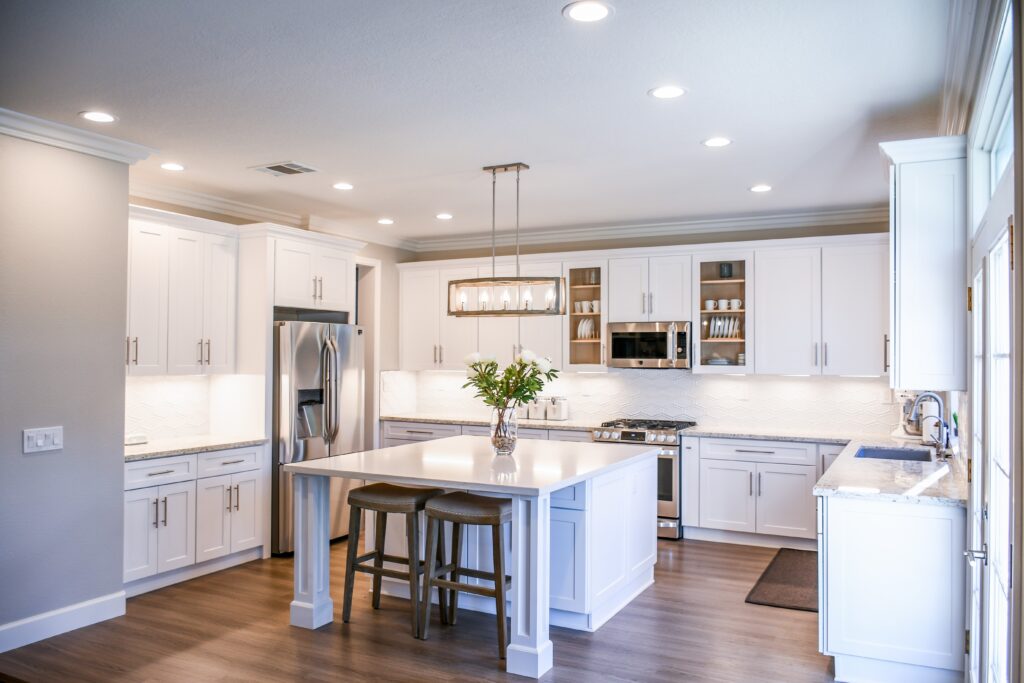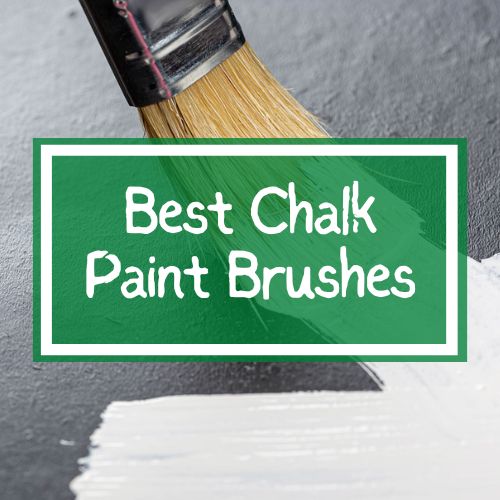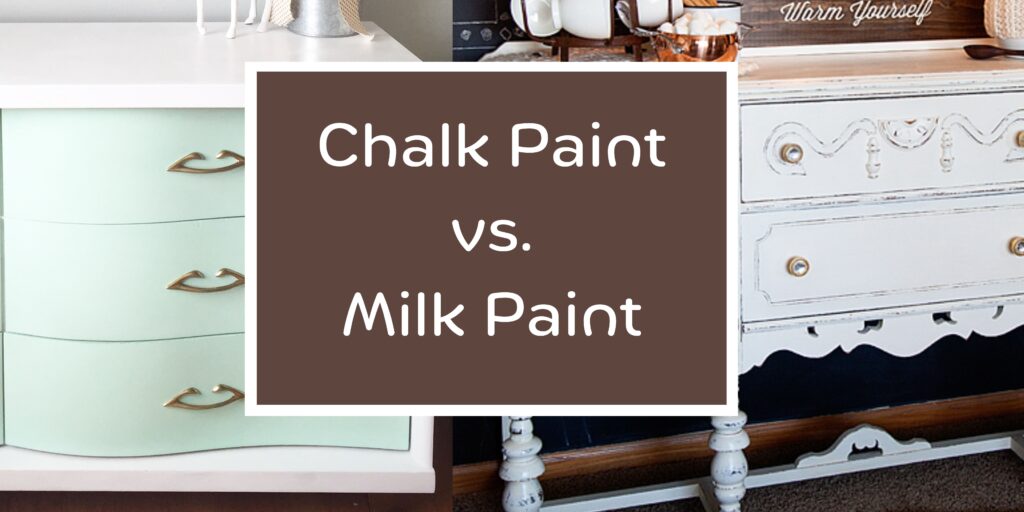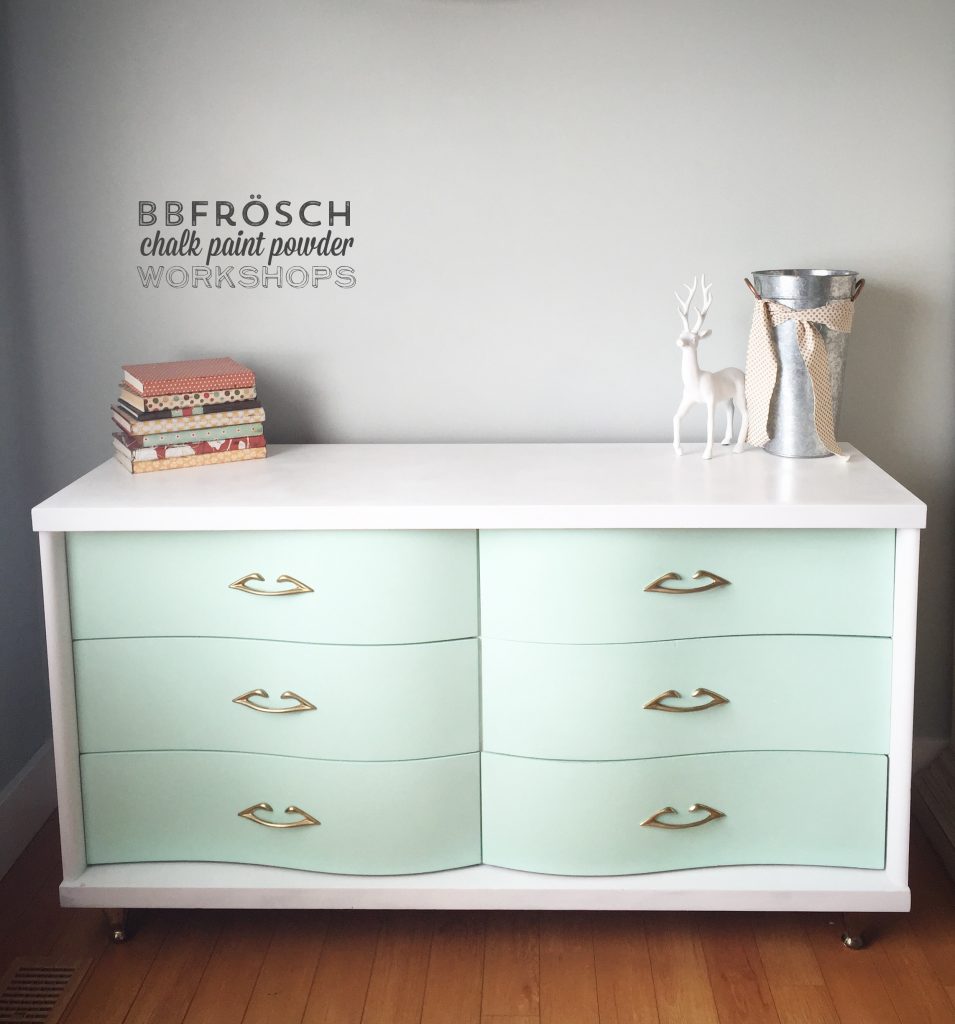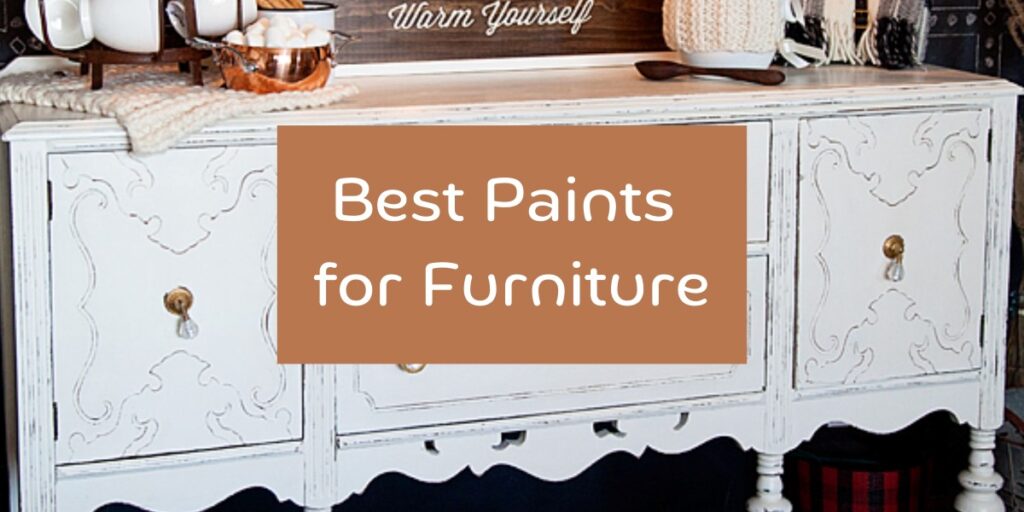 Looking for the best paints for furniture? Great. I’m going to make this as quick and easy as possible for you if you’re short on time and then go into detail (probably too much detail) to help you make the best choice for YOU.
Looking for the best paints for furniture? Great. I’m going to make this as quick and easy as possible for you if you’re short on time and then go into detail (probably too much detail) to help you make the best choice for YOU.
Painting furniture is a great way to bring new life to existing pieces or transform thrift store finds. The right colors and finishes can change a boring chair or end table into the focal point of any room.
Can You Use Any Paint For Furniture?
No. You can’t use any paint for furniture. You need to choose the right type of paint for the type of furniture you’re painting.
Choosing the right paint for the job can make the difference between something that looks like a designer piece, and (to be honest) something that looks like you just slapped some paint on it.
There are a variety of paints that can be used for furniture. However, there are also some that won’t be a good choice.
The easiest way to see if the paint you have is suitable for the furniture you want to paint is simply to read the label.
Paint that is formulated for plastic or metal is not going to adhere well to wood. Any paint labeled as “high temperature” is great for painting an outdoor grill or vehicle, but will eventually flake off of wood or wicker.
Why It’s Important To Choose The Right Wooden Furniture Paint
Choosing the best paint for your wooden furniture is crucial to keeping it looking good over several years.
It would be so disappointing to have your painted furniture showing scratches, chips, or stains after you spend time (and money) working on them.
Before choosing your paint, give consideration to how much daily use and what interactions your piece of furniture will have. Let’s say you have a basic wooden table that you want to paint.
You could choose from a number of different types of paint for this project, and with the right technique they could all turn out looking great. So how do you choose?
First, keep in mind that a table is a piece of furniture that is going to get a lot of regular use. You might be eating meals at this table, or playing games, or maybe you’ll use it just as a space to pay bills and check your email.
Regardless, the table will constantly have a number of items on the tabletop, as well as wear and tear from people touching it.
When choosing a paint for a piece of furniture like this table, you want to choose a paint and finish that will be durable enough to stand up to daily use. It would be a shame to spend the time and money to paint this table beautifully, only to have it scuff and chip within a year or so.
If you are going to paint something like a cabinet, end table, or hutch that will get touched on a regular but not daily basis, you might not have to worry about high durability quite as much.
You should still choose a paint and finish that will be resistant to wear and tear, but that doesn’t have to be the top priority.
You should also give consideration to the type of finish you choose for your painted furniture. Paint with a matte or satin finish or topcoat will be more prone to showing dust and dirt.
Semi-gloss or glossy finished pieces are going to be more resistant to any dirt and will be easier to keep clean.
What Is The Best Type Of Paint For Furniture?
The “best” paint for any furniture project will depend on how you want your finished piece to look, and what type of furniture you will be painting.
Here are some of the most common paint types for painting wood furniture:
Chalk Paint
Chalk paint is so trendy right now! It’s perfect if you want your furniture to have a velvety matte finish.
Chalk paint is also the best choice if you want to create a distressed look on any piece of furniture. This is the best choice if you want your painted furniture to fit in with a “farmhouse” or “country chic” aesthetic.
If you plan to use chalk paint on a surface that will be touched quite a bit, you will need to apply a protective wax sealant to keep this paint from scratching and chipping.
This will give it a very subtle sheen, but not enough to detract from the signature flat appearance chalk paint is known for. Most brands of chalk-style paints also have their own wax sealant available.
You might not need to use a primer with many brands of chalk paint, as it usually applies evenly and smoothly.
It is important to make sure it is completely dry between coats; this will make it more durable. Fortunately, chalk paint is known for having a quick drying time.
Chalk paint is one of the few paints that is non-toxic and has very little odor. It also cleans up very easily with just soap and warm water.
Milk Paint
Milk paint is also becoming quite trendy right now with home decor designers as well as home crafters. It is similar in appearance to chalk paint; as it has a lovely matte finish.
The finish does have a slight sheen to it, but it’s not noticeable enough to even be described as “satin”.
Milk paint is durable and actually cures to a more long-lasting hardness over time. If you want to be sure that your milk paint will be resistant to scratching and chipping, you can mix a bonding agent in with the paint powder.
If you want full opaque coverage with milk paint, it’s best to start with a primer coat. You’ll need at least two to three coats to get a solid finish. A single coat of milk paint can look semi-transparent, which can be used to create a sheer wash of color over a wood surface.
This technique is an easy way to create the look of a faded antique heirloom.
Milk paint is sold in powdered form that is mixed with an equal amount of water. The powdered paints can easily be combined to create a custom color.
It dries quickly and has very little to no odor. All milk paint powders are completely non-toxic, so they’re an excellent choice for painting furniture for children’s bedrooms.
Latex Paint
Latex paint is one of the most commonly available home paints. Wall paints are very often latex based. Because there are so many brands and they are readily available, latex is one of the more affordable options for home painting projects.
Another advantage of latex paint is the vast selection of colors available. Just about any color you can imagine can be found in a brand of latex paint. It’s also available in a variety of finishes, such as gloss, semi-gloss, and satin.
You can use latex paint for wood furniture, but it requires quite a bit of preparation. You’ll need to sand your furniture before painting.
Latex won’t adhere well to a smooth surface; it needs a little bit of texture to grip. Also, applying a primer coat is so important before painting with latex!
Even if the brand of paint you are using is described as “paint and primer in one”, you’ll get the best results if you start with a primer coat.
The possible downside to using latex paint on wood furniture is that it isn’t as durable over time as other paint formulas. Taking the time to properly prep your surface will help the paint last longer, but there are other options that are more long-lasting.
Acrylic Paint
Most of the specialty furniture paints and designer brand home decor paints are acrylic based. If the paint is labeled as “Paint and Primer In One”, it is also probably acrylic paint.
These paints are a good choice for wood furniture projects. In most instances, you can get away with not having to apply a primer or protective top coat.
You might still need to do a little bit of light sanding, especially if your surface originally had a shiny varnish on it.
Acrylic paint is known for being “self-leveling”.
This means that it will dry with little to no visible brushstrokes. It takes a little bit longer to dry than chalk paint or milk paint, but you might not need to use a protective top coat with this paint.
You can even distress it with a little sanding, but it’s not as easy to do this as it is with chalk paint or milk paint.
Alkyd-Hybrid Paint
Alkyd Hybrid (or Acrylic-Alkyd) Paint is a relatively new type of paint that has been widely available for the past decade or so. This paint is an enamel that is water-based instead of oil-based like traditional enamel paints.
This paint has beautiful vivid colors associated with oil paints, without harsh odors and harmful chemicals. It levels flawlessly, with a finish that will show no brush strokes or streaking.
It’s durable and highly resistant to scratches and scuff marks. It is also easy to clean with just soap and water. This type of paint is a good choice for kitchen furniture or any furniture that will experience a lot of daily wear and tear.
One downside to Alkyd Hybrid Paint is that it takes quite a while to fully cure. While it may feel dry to the touch in about a day, the actual curing time can take up to a week.
It’s best to not place anything on top of it or move it too much for a week to 10 days after painting.
Alkyd Hybrid Paint requires a bit more preparation work than some of the other paints. You’ll need to sand pretty thoroughly before applying, but you won’t need to apply a protective topcoat.
Oil Based Paint
Oil-based paints have beautiful color saturation and can be applied to almost any surface. They don’t show streaks or brushstrokes, and they’re probably the most durable paint choice for wood furniture.
It will saturate any porous surface, creating a smooth hard finish with each coat of paint. They do cost a bit more than other paint types, but this paint is strong and will look good for a long time.
However, there are some significant downsides to using oil paint. First and foremost, oil-based paints have a high VOC (volatile organic compound) content.
That means they’ll have a pronounced odor, and you will absolutely have to work in a well-ventilated area when using oil paint. VOCs are considered a mild health hazard; enough so that home decor oil paints are becoming increasingly harder to find in stores.
Oil paints take a long time to cure. It can take up to one or two days for it to feel dry between coats of paint.
You’ll need to use mineral spirits or turpentine to clean your brushes and tools when using oil paints. You can also use these as a paint thinner if the paint is thicker than you would like.
Which Type of Paints Have The Best Coverage For Furniture?
If you want a smooth opaque coverage on your painted furniture, you really can’t beat the results of using either acrylic or alkyd-hybrid paint. Both of these paints have gorgeous color saturation, and self-level and apply smoothly like acrylic paint. With alkyd paint, you might not even need to apply a primer coat. It’s easy to get flawless, full coverage in just a couple of coats of paint.
Chalk Paint can give you a lovely matte coverage with the right preparation. It can take several coats to get full coverage, though. The key to getting the best coverage with chalk paint is to sand your wood surface and apply a primer coat first.
Milk paint is a little tricky to use if you want a fully opaque coverage. For the best results, you should apply a primer coat to your sanded wood surface first. The first coat of milk paint might look a little bit semi-transparent. It usually takes three (or sometimes four) coats of milk paint for an opaque finish. Another trick to getting nice coverage from milk paint is to mix in a bonding agent.
Oil paints have beautiful colors and are easy to apply for a smooth, opaque finish. However, the downsides to using oil paints are that it tends to drip, and there is a long drying time between coats. You need to do quite a bit of sanding before painting with oil paints, and applying a primer coat will help you get the best results.
What Are The Best Brands For Wooden Furniture Paint?
Painting furniture is a popular hobby right now, and choosing the right brand of paint can be a daunting task. It’s always a good idea to do some online research and read user reviews of any product, but here are a few recommendations:
Best Acrylic Paint: Jolie Paint Matte Finish
Jolie Paint has created an acrylic paint with a pretty matte finish that truly resembles the look of chalk paint or milk paint. This paint comes in 44 trendy colors. It is non-toxic and has a low VOC content, and cleans up easily with soap and water. It is recommended to use a protective wax or polyurethane topcoat with this paint.
Best Chalk Paint: Retique It
Retique It brand of chalk paint has superior coverage and dries to a silky matte finish. It is manufactured in the U.S.A. Their neutral color shades are very popular and are perfect if you’re looking to create the appearance of an older piece of furniture. Like all chalk paints, they’re non-toxic, hypo-allergenic, and free of VOCs.
Best Milk Paint: Old Fashioned Milk Paint Co.
Old Fashioned Milk Paint Co. creates powdered paints in 32 classic and trendy colors. They specialize in colors meant to recreate the look of colonial furniture style. All their colors are vibrant and resistant to fading.
This powdered paint is made in small batches, and the unmixed powder will last for years. Milk paint is great for smaller to medium projects because you can mix up only as much paint as you need.
Best Alkyd Paint: Advance Waterborne by Benjamin Moore
Advance Waterborne is pricier than other brands, but the quality can’t be beaten. This paint has a self-leveling formula and a satin finish that makes it easy to achieve a professional-looking outcome on any painting project.
It covers so well that you might be able to finish with only one or two coats if you use a primer. It is available in any of the Benjamin Moore colors, so you can customize it to match your decor in any room.
Best Oil Paint: Rust-Oleum Protective Enamel
Rust-Oleum Protective Enamel sets the standard for affordable, high-quality oil enamel. It comes in many vibrant, long-lasting colors that are available in gloss, semi-gloss, and flat finishes. Rust-Oleum brand is known for curing to a hard protective finish and is perfect for wood or metal surfaces.
Unlike many oil paints, this brand will be dry to the touch in just three to four hours. It’s probably best to let the paint dry at overnight before applying a second coat, though.
You should work in a well-ventilated area when using this or any oil-based paint. It’s a good idea to keep some turpentine or mineral spirits on hand for clean-up, too.
Does Furniture Paint Need Primer?
It’s easy to get impatient with all the preparation needed for a painting project and want to skip the primer coat. Don’t skip this step. It can make a world of difference in how your painted furniture will look once all the painting is done. This is especially true if you’re using chalk paint or milk paint. Priming also helps your paint adhere to the wood better, and your lovely paint job will last much longer. It also helps to prevent the paint from chipping and scuffing. A coat of primer also prevents any dark wood grain or imperfections in the wood from showing through the paint.
There are a lot of paint brands that advertise as being “all in one” or “paint + primer”. Technically, you should be able to skip the primer coat if you use one of these paints. However, most of the time I still do a quick primer coat even when using an “all in one” style paint. If nothing else, the paint just glides on more evenly over a primed surface.
What’s The Best Paint For Upcycling Furniture?
Transforming old furniture from yard sales or thrift stores is such a fun creative outlet! You can take a very ordinary piece that might be several decades old, and with a little time and creativity, it can become a beautiful accent for your home.
There really isn’t any definite answer as to what paint is the best for upcycling. It genuinely depends on what you envision your finished project to look like.
For a classic “country” or “farmhouse” style, you can’t go wrong with chalk paint or milk paint. Both of these paints can be distressed if you want your furniture to have an authentic antique appearance.
A satin or semi-gloss finish acrylic or alkyd-hybrid paint are great choices for more contemporary styles. These types of paint can give you a more smooth finish and are available in a wide variety of colors.
What Are The Best Furniture Paint Colors?
Choosing the perfect color for your painted furniture should be fun, but it’s easy to get overwhelmed with choices. When trying to decide on a color, consider where in your home you’ll be displaying your painted furniture. You don’t have to match the colors in the room, but you can choose a color that is complimentary, or just in the same general pallete.
When in doubt, stick to neutrals or lighter shades. Neutral shades don’t have to be boring! Cream-colored furniture with dark hardware can look quite sophisticated. Pale gray tones are very trendy right now and look good with almost any decorating scheme.
What’s The Best White Paint For Furniture?
White is always a good color choice to bring new life to old furniture. It’s classic and seems to look subtly elegant on any type of furniture.
Choosing the “perfect” shade of white paint can seem a little confusing at first. Once you start looking at paint you’ll find yourself faced with choices of true white, warm & cool whites, eggshell, ivory, off-white, cream, and more!
Don’t panic! Figuring out which white paint to use really doesn’t need to be complicated. First, look at the space where you might display your painted furniture.
Is there any white in that room? If so, is it a bright white? Or is it more of a cream color? If you want your space to look like a professional designer put it together, try to match your white paint with whatever white might already be in the room.
The look of matching shades of white is subtle, but it ties a room together nicely.
The Best 3 White Paints
Benjamin Moore Decorator’s White is one of the most popular shades for home decor. It’s a favorite of interior decorators. The color is a clean classic white, that isn’t too bright or harsh. It has a soft tone, but you won’t notice any yellow undertones. You can get this lovely color in Benjamin Moore’s Advance Waterborne alkyd-hybrid paint.
Snow White, by Old Fashioned Milk Paint Co. is a good choice for a white milk paint. It has a soft cool undertone but doesn’t look gray. It actually looks like milk. It’s a nice soft shade that would work well as the main color or trim color on any wooden furniture.
Retique It Chalk Paint makes two wonderful shades of white paint. Ivory Tower is a warm white that looks like aged antique white paint. Warm undertones have a tendency to appear yellow when it comes to white paint, but this one just looks like antique ivory.
The other shade of white from Retique It that is popular is their Snow. It’s just what the name says: pure snowy white paint. It’s bright, without being harsh. This is a great color on its own or to mix with another shade for your own customized shade.
How To Prepare Wood Furniture For Paint
Now that you’ve read about different types of paint for furniture, let’s take a moment to “talk” about preparation. The key to getting great results on any painting project is to do the prep work. It’s not the most fun part of the job, and sometimes it can take more time than the actual painting. However, if you don’t take the time for some prep work you’ll be disappointed with your final project.
The first step is to clean the furniture you’re about to paint. Most of the time, it can be done with soap and water, but a household cleanser might be needed if there are any stains or spots.
The next step is sanding. This is particularly necessary if the furniture has any kind of glossy/varnished finish on it. You don’t have to sand all the way down to bare wood. You’re trying to scuff up the surface enough that the wood will be porous. This will help any primer and/or paint stick to it easier. Paint won’t adhere to a shiny varnished surface, so sanding is really important if you’re upcycling an older piece of furniture.
After you’ve sanded the furniture, you need to clean it again. This will be easier than the first cleaning. The goal here is to wipe away all of the dust from the sanding you just finished. You can usually do this with a damp cloth.
If there are any holes or deep scratches you want to repair, now is the time to do it. Wood putty is available at any home improvement store or online, and it’s very easy to apply. Simply spread it into the hole, scrape it evenly across the surface with a putty knife, and let it dry. Drying times can vary, so read the instructions.
If there are any sections of the furniture where you don’t want paint, now is the time to cover them with painters’ tape. This includes any hardware if you didn’t remove it already. Be sure the edges of your tape are stuck down smoothly so no paint will seep underneath.
Now it’s time to apply the primer coat! Primers do come in different shades. As a general rule, it’s best to use a light-colored primer under light colors, and a darker primer under medium to dark colors. Primer is easy to brush on; just make sure you get an even coat over the entire piece of furniture. Allow enough time for the primer to dry completely, and you’re ready to paint!
How To Apply Paint For Wood Furniture
You’re done with all the tedious prep work and are finally ready to paint! Your first step is to inspect the piece you’re going to paint. Make sure you don’t miss any spots when you apply the primer. Look for any dust or hair that might be on it; you don’t want to accidentally paint over any.
Depending on the size and shape of the furniture you’re about to paint, you need to decide what kind of tools you’ll use for painting. Brushes of assorted sizes work for any job. If your project has tight corners, intricate details, or small areas like table legs, you’ll need some smaller brushes as well as larger ones. Wide brushes or rollers are perfect for broad flat surfaces.
Thin, even coats of paint will give you professional results. Several thinner coats are better than one or two thick coats. Thicker coats of paint won’t stick to the furniture as well and will be more prone to scratching and shipping.
For the first coat of paint, brush or roll your paint in the same direction as the wood grain as much as possible. Allow enough time for the paint to fully dry before applying your second coat. For the next coat of paint, you can brush or roll the paint in the opposite direction. This will help give you full coverage that doesn’t show any streaks or brush strokes.
When painting a vertical surface, be mindful of any drips and smooth them out as soon as you can. You don’t want to find drips after your paint has already dried!
If you want a semi-transparent washed finish, with some of the wood grain or prior paint job showing through, brush the paint in a very thin coat in the same direction as the wood grain. If the paint is going on too thickly, wipe it gently with a rag, again moving in the same direction as the wood grain.
Should You Use A Sprayer Or Brush For Furniture?
Whether you use traditional brushes or a paint sprayer for your project is completely up to you. You can achieve great results with either method.
Spraying will work better if you’re painting a large piece of furniture, while brushes might give you better control over small and more intricate pieces. Painting with brushes and rollers will take you a little longer than using a sprayer.
Paint sprayers typically can cost anywhere from $50 to $150 on average. If you paint furniture on a regular basis, it’s worth purchasing one to add to your DIY supplies. If you’re new to furniture painting, or only do it once in a while, using brushes and rollers might be a more budget-friendly option for you.
Sprayers are relatively easy to operate, but it does take a little practice. Sprayers do an excellent job of creating a painted surface absolutely free of any brushstrokes. The key to getting that perfectly smooth appearance is to keep your arm moving at all times when using a paint sprayer. Holding the sprayer in place will make your paint drip, and the coverage will be uneven. Before painting on your wood furniture, it’s a good idea to practice with the sprayer on a large piece of cardboard to get used to how it operates, and to make sure your paint is the right consistency.
The best paints to use in a sprayer will be thinner in their consistency. Most paints can be thinned out with a little water. The exception to this is oil-based paint. You’ll need to use mineral spirits or turpentine to thin out oil paints. It’s best to check the label of whatever paint you choose to find out if it is suitable for use in a paint sprayer.
If you use a sprayer, it’s important to wear a face mask and goggles to protect yourself from overspray. You should only use a sprayer in a well-ventilated area. If you’re spraying inside, but sure to cover the floor, walls, and anything else around your workspace so you don’t get overspray on them.
Is There A Difference Between Wood Furniture Paint And Metal Furniture Paint?
The short answer to this question is: yes, there is a difference between paint used for wood furniture and metal furniture. You should always make sure the paint you use is suitable for the surface you’re painting.
Any paint that is meant to be used for metal surfaces will be formulated to resist rust, corrosion, and adverse weather conditions.
You will still need to use primer, but because this type of paint is meant to be protective as well as decorative, you won’t need a top coat.
You can use paint meant for metal on wood furniture, but the paint will soak into the wood much more than other paint types. You can offset having too much paint soak into your wood by applying a coat or two of primer before painting.
If you try to use paint that is made for wood on a metal surface, it probably won’t work very well. Even with a primer coat, the wood is not going to stick as well, and it will be more likely to run and drip.
If you’re going to paint metal furniture meant for outdoor use, paint formulated for wood is not going to hold up well against the elements.
Summary of the Best Paint for Furniture
Whew! What a long post. It’s hard to put all of this into words to make it
Painting furniture is such a satisfying hobby! If it’s something you’ve been wanting to try, hopefully, this has helped to answer some questions for you.
Like any home project, having an idea of the best products to buy and how to use them will make the job easier and more fun.
